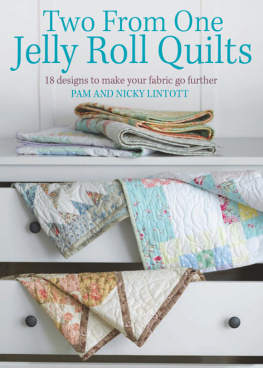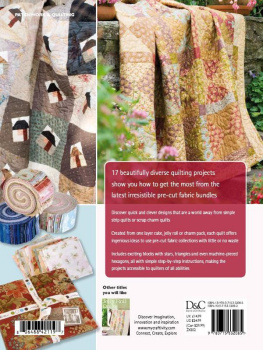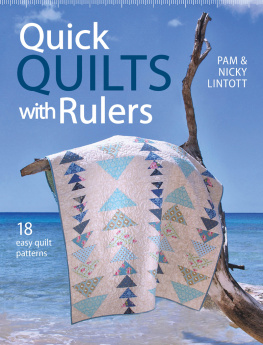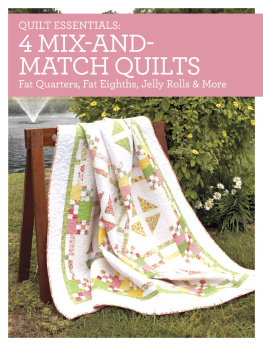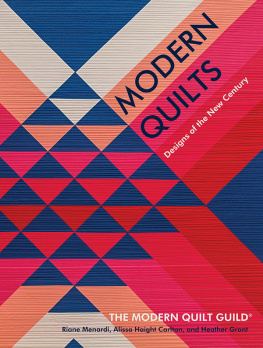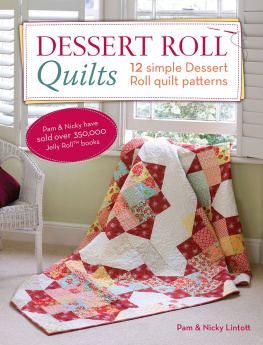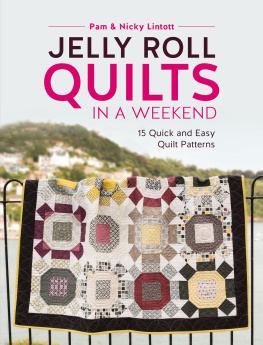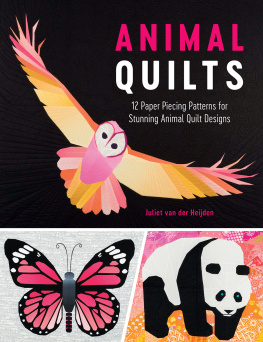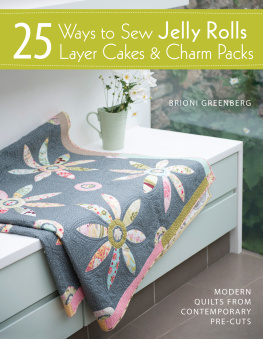NEW WAYS WITH
JELLY ROLLS
12 REVERSIBLE MODERN JELLY ROLL QUILTS
PAM & NICKY LINTOTT

CONTENTS
Introduction
Having written eight best-selling jelly roll quilt books you probably know by now that we love making jelly roll quilts. The basis of all the quilts in our previous books has been that with just one jelly roll you could make any of the quilts. This made things so simple choose a jelly roll, choose a quilt pattern and away you go! This book, however, is a little bit different.
We love traditional quilts but we also love the look of modern quilts and our latest quilts are certainly being influenced by the modern quilt movement. One of the things we like about contemporary quilts is the negative space for showcasing lots of gorgeous quilting, but we found that when making our quilts we often did not need to use the whole jelly roll. For those who are familiar with our work you know that we dont like to waste fabric, so we have come up with the perfect solution. For this book we have also pieced our quilt backs and in doing so were able to put any excess jelly roll strips and pieced strip units to very good use. This idea created some stunning quilt backs and we show you how you can do the same. There is a certain freedom when piecing a quilt back taking this approach allowed us to try something new and be more creative and the end result was that we made a totally reversible jelly roll quilt! We have made our quilt backs approximately 4in larger all round than our quilt tops to allow sufficient fabric if longarm quilting.
We hope you enjoy the quilts in this book, and remember that you can play around with our designs as much as you like. You can look on our patterns as a starting point for creating your own unique designs there are no boundaries.

Getting Started
What is a Jelly Roll?
A jelly roll is a roll of forty fabrics cut in 212in wide strips across the width of the fabric. Moda introduced jelly rolls to showcase new fabric ranges. How inspirational to have one 212in wide strip of each new fabric wrapped up so deliciously! If you want to make any of the jelly roll quilts in this book and dont have a jelly roll to use, then cut a 212in wide strip from forty fabrics from your stash and you can follow all the instructions in just the same way. Our patterns are based on a jelly roll strip being 42in long.
Imperial or Metric?
Jelly rolls from Moda are cut 212in wide and at The Quilt Room we have continued to cut our strip bundles 212in wide. When quilt making, it is impossible to mix metric and imperial measurements. It would be absurd to have a 212in strip and tell you to cut it 6cm to make a square! It wouldnt be square and nothing would fit. This caused a dilemma when writing instructions for the quilts and a decision had to be made. All our instructions therefore are written in inches. To convert inches to centimetres, multiply the inch measurement by 2.54. For your convenience, any extra fabric you will need, given in the Requirements panel at the start of the quilt instructions, is given in both metric and imperial.
Quilt Sizes
In this book we have shown what can be achieved with just one jelly roll. We have added background fabric and borders but the basis of each quilt is just one jelly roll. The size of our quilts is therefore restricted to this fact but there is nothing to stop you using more fabric and increasing the size of your quilt. The Vital Statistics in each chapter give you all the information you need to enable you to do some simple calculations to make a larger quilt.
Seam Allowance
We cannot stress enough the importance of maintaining an accurate scant 14in seam allowance throughout. Please take the time to check your seam allowance with the seam allowance test at the back of the book.
Tools Used
When cutting half-square triangles from strips, we use the Multi-Size 45/90 from Creative Grids, which has markings that refer to the finished size. If you are using a different ruler when cutting half-square triangles, please make sure you are using the correct markings before cutting. For some of the quilts we have also used a large 60-degree triangle ruler that can measure up to 8in triangles.
Diagrams
Diagrams have been provided to help you make the quilts and these are normally beneath or beside the relevant stepped instruction. The direction in which fabric should be pressed is indicated by arrows on the diagrams. The reverse side of the fabric is usually shown in a lighter colour than the right side.
Washing Notes
It is important that pre-cut fabric is not washed before use. Save the washing until your quilt is complete and then make use of a colour catcher in the wash, or possibly dry clean.
Before You Start
Before you dive into making a quilt please read all of the instructions fully and dont forget to keep that scant 14in seam allowance. Most of all have fun! We designed these quilts to be easy to make and we hope they will be well used and loved. The techniques we use do encourage accuracy but no one is going to be judging you on every last point.

Return to Sender
This striking quilt, with its clean, contemporary layout, is quick and easy to make and uses all but four strips of the jelly roll. We used one of the distinctive ranges designed by V&Co for Moda, which has stunning geometric designs. These fabrics and the geometric layout we used for the quilt creates a very fresh, modern design.
The four spare jelly roll strips were put to good use by making four larger versions of the block and piecing them into the backing fabric to create a totally different, minimalist look on the reverse of the quilt.
Vital Statistics
Quilt size: 5212in x 66in
Block size: 6in x 12in
Number of blocks: 36
Setting: 9 rows of 4 blocks, plus 112in sashing
Requirements
For quilt top:
- One jelly roll OR forty assorted 212in strips cut across the width of the fabric
- Sashing fabric 112yd (1.4m)
- Binding fabric 12yd (50cm)
For pieced quilt back:
- Backing fabric 312yd (3.25m)
- Four spare strips from the jelly roll
Return to Sender Quilt
Preparation
Sorting the jelly roll strips:
- Choose thirty-six jelly roll strips for the blocks and pair up the strips to form eighteen pairs.
- Four jelly roll strips are spare and can be used for the pieced quilt back.
Cutting the jelly roll strips:
- Cut each of the thirty-six jelly roll strips as follows.
- Two rectangles 212in x 1212in.
- Two 212in squares.
- One rectangle 212in x 812in.
Cutting the sashing fabric:
- Cut twelve 2in strips lengthways down the fabric.
- Set eight of these strips aside for the horizontal sashing, which will be trimmed to size later.
- Take the four remaining 2in strips and subcut thirty-one rectangles each 2in x 612in for the vertical sashing strips.


